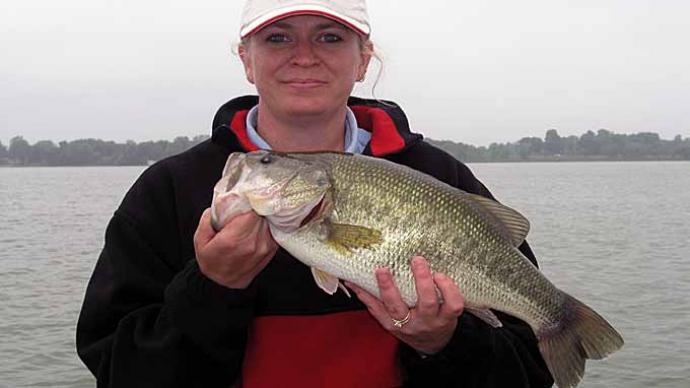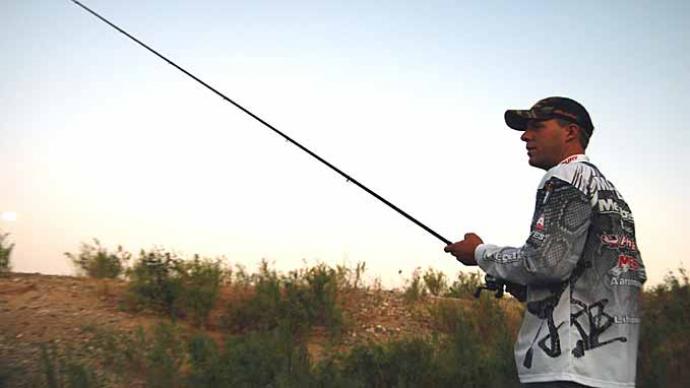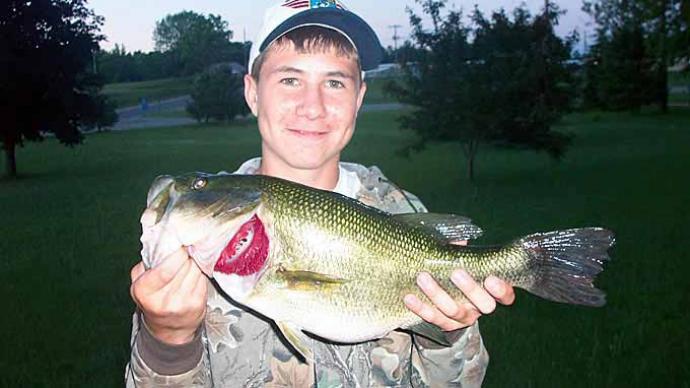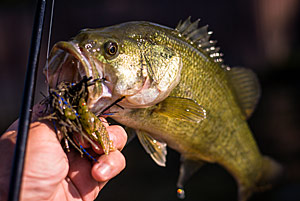
There is no denying that this question has the potential to spark the longest, most in-depth conversations among bass anglers. It’s not how fast their boat goes, though, that might come in a close second. The question is, if you only had only one lure to use, what would it be?
An argument can be made for spinnerbaits because of their versatility. A plastic worm ranks high, too. However, more often than not, the jig will be the chosen one.
It’s a basic lure featuring a weighted hook, skirt, and trailer. That simplicity can breed confusion in anglers who have never experienced its fish-catching power. Before they get that first bite, it can be tough to know when it’s being fished correctly. Historically, jigs shine in cold water or heavy cover, but they can be powerful in other situations.
For example, when water temperatures rise, bass move from pre-spawn through post-spawn. Other baits will score during these times. Jerkbaits will catch their fair share, as will spinnerbaits and crankbaits. The jig shines because it allows anglers to adapt quickly when bass move to different cover or change depths. Adjusting the trailer can match a jig precisely to their temperament.
This past winter was one of the toughest on record for the Northern portions of the country. Even in mid-April, most of the Great Lakes — which do not entirely freeze during an average winter — were still covered with ice. That means anglers will still work with cold temperatures and pre-spawn bass for most of May. Once water temperatures rise through the 40s and into the low 50s, bass begin pulling up to pre-spawn locations. That’s true in the North or South. Regardless of where you fish, the best spots are those close to spawning flats and deeper water, providing bass security during changing conditions.
They know where to go to spawn; they need somewhere to wait until the conditions are right. With that in mind, you should scout spots that offer a launching point for bass looking to spawn. Long points stretching from shallow bays to deep water are the first to try. Pockets are great places to start, especially those closer to a main point. These areas offer refuge and warmer temperatures, especially if sheltered from north winds. The pockets may not have enough spawning area to keep bass for long, but the bass will follow the points back to larger, shallow flats. Even pockets on stretches of banks that parallel the main channel can be good early in pre-spawn.
You’ll want to find deep enough backwater on a river system to offer bass security as springtime water levels go up and down with snow-melt runoff or rain.
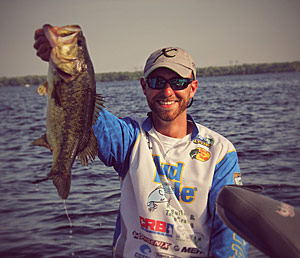
Fayetteville, Tenn., angler Brandon Lester is fishing his rookie year on the Bassmaster Elite Series. While the Tour level may be new to him, fishing isn’t. He had to qualify to get there, and jigs played a big part in getting that done, including a top-10 finish at a recent tournament at Smith Lake in Alabama.
He says bass want to go to the bank once the water temperature rises to 55. He starts fishing pockets, casting his jig to bushes and laydowns. It’s target fishing. He also fishes stumps, rocks, and docks. He might go into a pocket to fish one target. Doing so has resulted in Lester catching big, pre-spawn bass numerous times.
During the pre-spawn period, water temperature is the best guide for determining your speed, how long you spend on a spot or piece of cover, and the retrieve. The water will be cold, so you’ll need to slow down. To some degree, you’ll be able to increase your speed as the pre-spawn period progresses, but deliberate casts pay off more during this time.
Let the jig soak in a piece of cover. You also need to cast to all parts of it. If the next dock has eight posts and a ladder, expect to make a minimum of nine casts. Just like when you’re making your way to the coffeemaker in the morning, yawning and stumbling, the bass are just coming out of their slowest part of the year — winter. Bass are in these spots for convenience, not because the water has them revved up.
Lake Wylie is an impoundment located on the North Carolina and South Carolina border. There, I learned how important the weight of a jig could be to putting bass in the boat. It was March, and water temperatures were in the mid-50s. It was primetime pre-spawn jig fishing, but the bites were not coming on heavier jigs — which make pitching so much easier — fished on the bottom.
But bass would devour a ¼-ounce jig that floated in front of them. Floating may be a slight exaggeration, but when one was skipped under a dock or into a laydown with at least 5 feet under it, its big trailer would slow its fall to a crawl, giving bass more time to bite and hold the lure. The best trailers for this technique have a large amount of surface area, like a Zoom Super Chunk or NetBait Paca Craw. That characteristic acts like a parachute, slowing the light jig’s fall through the water column. This technique is not about traditionally working the jig: letting it hit bottom and hopping it back to the boat. You’ll still work it with pauses, hops, and pops, but the jig will float between the dock's underside or laydown and the bottom.
Lester will sort through black-and-blue, brown, or green-pumpkin ones till he finds what bass want the most on a particular day. Regardless of color, bass want a meal, so bring out the big trailers. Some action is nice, but the bulk is more important. Even a trailer with tails that don’t kick can affect how a jig works, making it glide or catch enough current to gently rock while it sits on the bottom.
Pre-spawn bites are subtle, whether you’re floating a jig or fishing it on the bottom. This is a situation where braided line can help. With zero stretch, it transmits even the slightest bump. If you’re fishing stained or clear water, it never hurts to tie on a short, 3- to 4-feet long monofilament or fluorocarbon leader using a double-uni knot. The less-visible separation between your jig and braid also might give you some confidence. You don’t need the kite-string-sized braid popular with the flipping crowd. Most pre-spawn situations need no more than 50-pound test braid and a 15-pound leader.
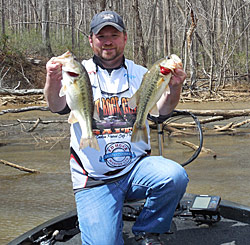
Learning how to skip your jig way up under a dock or inside a laydown will also help you catch more pre-spawn bass. The key is patience and practice. Learn the most successful angle and distance for approaching a piece of cover. That seems to be the best way to increase the percentage of skips you get into tight spots. A shorter rod – between 6 and 7 feet – rather than a straight-up flipping rod will get you into the swing of things quicker, too. It will be lighter, and you’ll be able to angle it better for the perfect skip.
It might seem unnecessary, especially since you’ve been catching pre-spawn chunks on it, but once bass move onto the beds, it’s time to give the jig a break. Soft plastics reign this time of year. They enter the water quietly and offer more action, even when sitting still. That better matches the mood of spawning bass. But once the spawn is over, the jig will shine again. As the water continues to warm during post-spawn, bass will be on the move, and so should your presentations. On many Southern lakes, once the bass are done spawning, it’s time for the shad to spawn. Shad spawn along grass edges, riprap banks, and boat docks. This activity is the sign Lester needs to pick up his jig again, but he won’t be fishing it on the bottom. It’s time to swim it.
Lester’s swim jig color choices include black and blue for dirty water and white or shad colors in stained or clear water. Regardless of color, he likes to throw a 3/8-ounce jig. The trailer is essential, but for different reasons. Under a steady retrieve, you’ll want one that catches a lot of water and kicks strong, even at slower speeds. Single and double-tail grubs are popular, as are the newer craw-shaped chunks with wedge-shaped pinchers. They catch water when flatter ones won’t, flipping and flapping on the retrieve.
Your casts should be placed similar to fishing reaction baits such as square-bill crankbaits, spinnerbaits, or even buzzbaits. Make sure you’re coming past as many ambush points as possible, both hard cover such as docks and shade lines. Adjust your retrieve, so the jig swims along right at the depth where it starts to disappear from your sight. That is an edge for bass, and they’ll work it like shade. Seeing your jig some will help you detect softer bites — if it disappears, set the hook. You also will want to choose a slower rod than the heavy-action one you flip and pitch with. By using a medium-heavy or even medium rod, you’ll add delay to your hook sets. That will give bass a chance to get a good bit on the jig and close its mouth before you set the hook.
In addition to swimming a jig, post-spawn is when flipping and pitching jigs come into play. Those techniques allow you to fish fast and keep up with moving bass. Keep in mind that the bass are headed in the opposite direction now. Instead of gathering at one jumping-off spot during pre-spawn, they are hopscotching, moving from any piece of cover or structure to the next, working their way to deeper summer spots. That’s why you will catch one here and there. Some will remain shallow, of course, and you’ll be able to pick them off, too. But do not discount what’s behind you as you work down a bank.
Most post-spawn bass will hit a jig on its initial drop. You might get a strike on the second or third hop, but you’ll be rewarded more if you keep your presentations quick and make frequent pitches and flips. That happened to me on Cayuga Lake, the second largest of New York’s Finger Lakes. Summer just started, and the bass were done spawning. I saw panfish and some bass swimming around shallow cover — docks, riprap, laydowns, and reeds. After emptying every tackle compartment in my boat, I finally started catching them, making long casts with a floating worm. They’d bite on the first or second twitch. I was fishing a tournament and needed bigger bass. I tied on a jig and dialed them in. The bass would hit on the end of a long pitch if it landed tight to the cover. They were ready to eat. It didn’t take a lot of finesse to get them to bite.
With just a few adjustments, jigs can take you through both pre-spawn and post-spawn fishing. Remember to match your retrieve and your jigs to the water temperature and your location to the bass’s seasonal movements. And, who knows, if you take your buddy along, he might end up with a new favorite bait.


